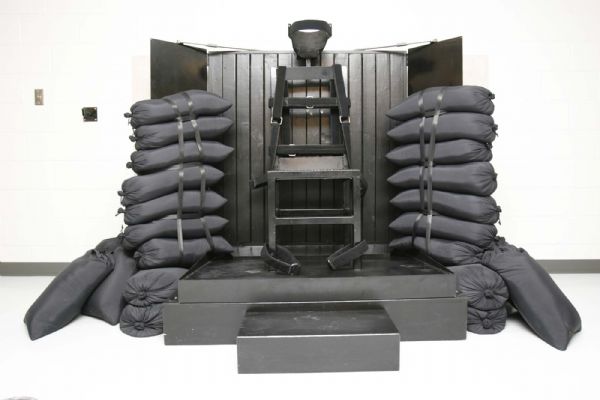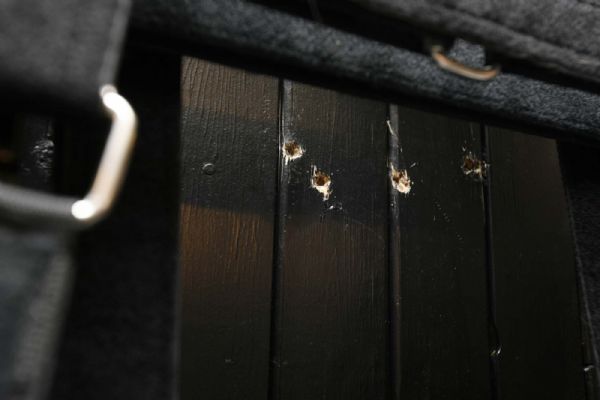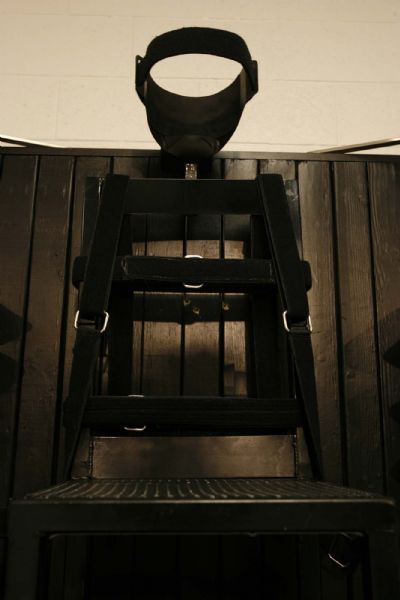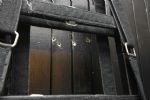This is an archived article that was published on sltrib.com in 2010, and information in the article may be outdated. It is provided only for personal research purposes and may not be reprinted.
Draper » Ronnie Lee Gardner's head, covered by a black hood, remained upright. His body sat straight in the chair to which he was strapped.
As my eyes traveled down Gardner's left arm, past his dark blue jumpsuit, I saw his pale white skin appear below his elbow. Half a faded blue tattoo, some kind of diamond shape, stuck out from the restraint around his wrist.
At the bottom of his restraint, I focused on his fist. Gardner died much the way he lived -- with a clenched fist.
Yes, this was my first time witnessing an execution. I have been amazed at how many people have asked me that.
Firing four bullets into a man's chest is, by definition, violent. If it can also be clinical and sterile, then that also happened in this execution.
Eight other journalists and I had our own viewing area with about a 6-foot-wide bulletproof window. When the curtain opened, there sat Gardner. We were at about a 45-degree angle to his left.
He looked nothing like the athletic 23-year-old with the red hair who murdered Melvyn Otterstrom in a robbery, nor did he flash that grin that defined those infamous photographs of him shackled on the courthouse lawn after killing Michael Burdell and wounding Nick Kirk in 1985.
This time, he looked like Utah's own ghost of Hannibal Lecter. Gardner's skin and his white socks contrasted with the dark blue jump suit he wore and the restraints, chair, wooden backdrop and sandbags, all of which were painted black. Restraints circled his wrists, ankles, shoulders and waist, but the restraint across his forehead best exemplified his confinement to me.
Gardner could not even look around the room and the fluorescent lights in the ceiling tiles illuminated his bald head and pale face.
Over his left breast clung a white square, about 2 inches by 2 inches, with a circle in the middle.
The room had no decor. The floor was white, as were the cinder-block walls. The two slits for the shooters cut into the wall opposite Gardner and the observation windows lined the two perpendicular sides.
Steven Turley, warden at the Draper prison, picked up a microphone and announced Gardner had two minutes to say his final words. When Turley asked Gardner if he had anything to say, Gardner said, "I do not. No." Gardner moved his head ever so slightly, trying to shake it.
Gardner's final words were to say he had none.
Turley hung up the microphone, then reached up and gently pulled a hood over Gardner's head. Turley picked up the microphone, unplugged its cord from a wall jack, wound the cord in his hand and exited the room.
Over the next 30 seconds, my heart raced. I realized the five gunmen would launch their volleys any moment. I placed a Styrofoam plug in my right ear to match the one I had earlier placed in my left. The other reporters and I stood in front of the glass.
I watched Gardner. As the seconds passed, I grew anxious. I pivoted my eyes away from Gardner toward the slits.
In that fraction of a second my eyes were in transit, I heard "boom boom." The sounds were as close together as you could spew them from your mouth.
My eyes darted back to Gardner and to his chest. The target, perfect just a second earlier, had three holes. The largest hole was in the top half of the circle and toward Gardner's left side. It may have been where two bullets entered Gardner.
Below that hole, still inside the circle, was a smaller hole. Outside the circle, in the bottom right of the target, was a third hole. Each hole had a black outline. Utah Department of Corrections Director Tom Patterson would say later the target was fastened to the jumpsuit by Velcro, and that may have accounted for the black outline.
I watched Gardner's torso. The firing squad members who shot John Albert Taylor in 1996 said they saw Taylor's body slump and I assumed Gardner's would, too. But I never saw such a movement. Instead, a few seconds after the gunshots, I saw Gardner move his left arm. He pushed it forward about 2 inches against the restraints. In that same motion, he closed his hand and made a fist.
Then it happened in reverse. Gardner's hand loosened, his arm bent at the elbow, straightened again and the fist returned. At the time, I interpreted this as Gardner suffering -- clenching his fist in an effort to fight the pain.
As I write this, I don't know whether that's true. It could have just been reflexes or some other process the body begins after a major trauma. Scientists do not know much about what a person shot through the heart feels.
The next movement I saw from Gardner came from beneath his hood. I could see the bottom of his throat and it rippled as though Gardner moved his jaw.
I squinted my eyes, looking for blood. I saw none through the holes in Gardner's chest. None spilled on the floor. The jump suit slightly darkened around his waist and it appeared that's where blood was pooling. But I never saw a drop.
About two minutes passed after the gunshots. It was long enough that I wondered (and some of my colleagues later said they wondered, too) whether Gardner would require a second volley of bullets to die.
Through a side door walked a man in a button-down shirt, slacks and blue plastic gloves. He lifted Gardner's hood only enough to check the pulse on the left side of Gardner's neck. The man appeared to do the same on Gardner's right.
Then the man lifted the hood high enough to shine his small flashlight in Gardner's eyes. When he did this I could see Gardner's face. His mouth was agape. His face was even whiter than it was before the hood covered him.
The man withdrew his flashlight and let the hood fall again. He shut off the flashlight and started to walk out of the room. Gardner was dead.
Turley and Lowell Clark, the director of division institutional operations for the Department of Corrections, entered the chamber. Clark grasped the curtain on my side and Turley grabbed the curtain on the opposite wall.
As Clark pulled the curtain along its rod, I pushed my head toward the glass to take one final look at the scene. In the final second, my eyes focused on the straightened left arm, seemingly flexing, and that clenched fist.
Shots, a fist and an excruciating wait for Gardner to die
Witness to the firing squad









